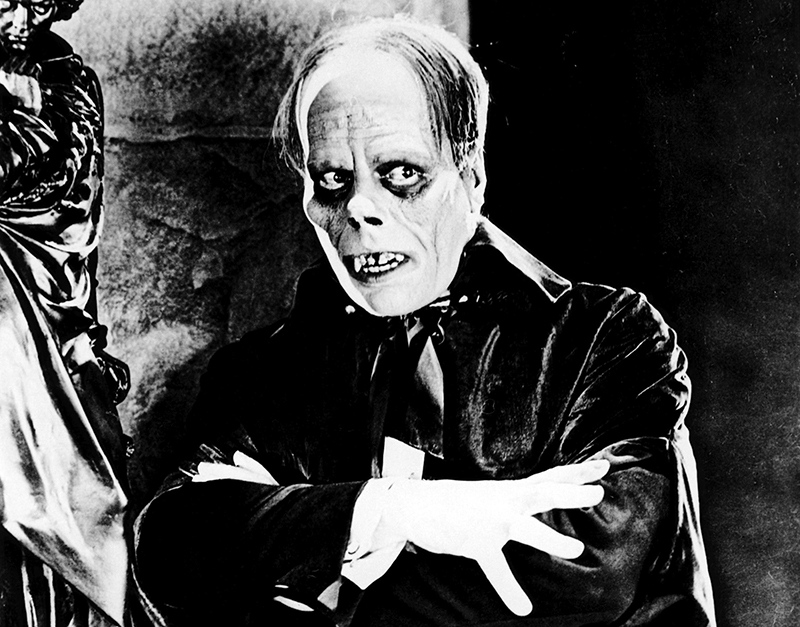Andrew Downing’s Phantom menace
By Kelsey Klassen
Before he was the star of Broadway’s longest-running musical, the Phantom of the Opera could be found haunting the catacombs below the Paris Opera House in a 1925 silent film.
Even without sound, Rupert Julian’s black and white gothic romance was, by all accounts, a terrifying ordeal for moviegoers at the time, made all the more ghastly by the groundbreaking makeup effects transforming actor Lon Chaney, Sr. into the menacing, Christine-loving Phantom.
As was customary at the time, the film was intended to be screened with live musical accompaniment to help set the mood; however, in fitting fashion for a story about an illusory opera ghost, no information survives as to what the original score sounded like – only the Universal Pictures release crediting it to composer Joseph Carl Briel (of Birth of a Nation fame).
Andrew Downing probably wouldn’t have wanted to listen to it anyway, though. TheToronto-based composer says he was looking to create something entirely new when he sat down to write a contemporary score for the seminal horror flick.
“When an audience watches a movie from 100 years ago, a lot of things have changed since then,” says the Juno Award-winning jazz musician, speaking with Westender by phone. “The way people act, the way they overact sometimes, and the way things are construed.
“[The movie] would have been very, very scary at the time,” he continues, “and now it’s not so horrific, so in that way, I can have a bit more fun than maybe somebody would have 100 years ago. Something that is supposed to be scary […] I can treat it as melodramatic and be a bit more humorous with my interpretation of what’s happening on screen.”
When he performs his score as part of a seven-piece chamber orchestra, backed by the 100-voice Vancouver Bach Choir at the Orpheum this Saturday, he’ll also be steering clear of too many string-filled Andrew Lloyd Webber references.
“I tried to just stay away from it,” he says, of the 1986 musical, which gave us such showstopping tunes as “Music of the Night” and “All I Ask of You”. “So any of the very famous kind of musical clichés Andrew Lloyd Webber put in, I tried to make sure that there was nothing really close to that just so it doesn’t feel related. I want it to feel like a new thing.”
Silent films became a point of fascination for Downing, a double bass player who teaches at the University of Toronto, after he was asked to improvise the score toPhantom for an outdoor film party being thrown by the Jackson Triggs winery in Ontario in 2003.
Downing says the experience of playing along with a movie live was inspirational.
“It actually makes it easier to write or play music,” Downing explains, “because something else is giving you the content, something else is giving you the mood.”
After the winery event, Downing’s friend, conductor Leslie Dala of the Vancouver Bach Choir, approached him with the idea to flesh out his score for voice, as well. Downing created vocal parts based on snippets of text from the silent film, and they debuted their creation here in 2013.
Now three years later, they’re bringing it back; which is understandable, given the fact that, of all the silent films Downing has scored since (six, including The Cabinet of Dr. Caligari and The Shock), Phantom is still one of his favourites.
“This one’s up there,” he confirms. “Partly because it’s such a thrill to do with the choir. I’m playing the double bass with the chamber group, and it’s such a rush to sit up there and hear these people kind of yelling at me,” he laughs.
It’s also a thrill to be led by Dala, who, Downing says, knows instinctively how to sync the written music up with the action in the movie.
“Les is a very, very good conductor,” says Downing, “so when he sees a tempo marking on the page – like, ‘quarter note equals 120 beats per minute’ – he knows exactly what that feels like, so he can guide us through it to make sure everything lines up where it’s supposed to.”
And while you might think that the whole evening is leading up the big reveal – the moment Christine rips away the Phantom’s mask and sees his face – Downing actually looks forward most to the movie’s longer scenes – the moments when the camera treats the opera house like an Iñárritu landscape.
“Some of my favourite moments, for the performance of it, are the few scenes that I call travelling scenes,” he says. “They were shot in a way that, [because] the cinematography was so beautiful, they wanted these scenes to last a long time,” he explains. “For example, there’s one scene where the Phantom puts Christine on a horse and they travel through the catacombs under the opera. That’s one of the parts where I include a lot of improvising for the musicians. There’s a groove happening, and we can be kind of playful with these weird and beautiful images that aren’t really integral to the story, but are just beautiful pieces of film to watch.”
Published February 2016, Westender
http://www.westender.com/arts-culture/music/andrew-downing-s-phantom-menace-1.2175168
